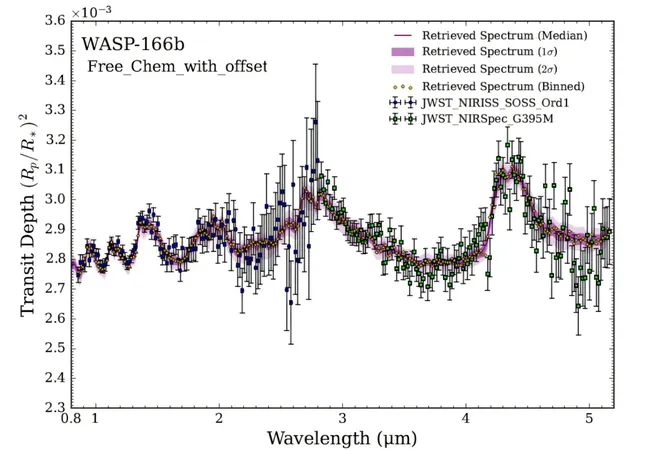
Exciting Discovery: Water and Carbon Dioxide Found on Distant Super-Neptune Exoplanet!
2025-01-09
Author: Amelia
Exciting Discovery: Water and Carbon Dioxide Found on Distant Super-Neptune Exoplanet!
In an astounding breakthrough, astronomers using the James Webb Space Telescope (JWST) have made a significant discovery regarding the atmosphere of a hot super-Neptune exoplanet known as WASP-166 b. Their findings indicate that this distant world is not only massive but also possesses water and carbon dioxide in its atmosphere—two crucial components that intrigue scientists about the potential for life beyond Earth.
Characteristics of WASP-166 b
WASP-166 b is an enormous planet, approximately seven times the size and 32 times the mass of Earth. Orbiting its parent star every 5.44 days from a mere 0.067 AU away, the exoplanet experiences extreme temperatures, with an estimated equilibrium temperature soaring at around 1,270 K. Its characteristics place it within the so-called "hot Neptune desert," a sparsely populated region in our galaxy where planets of similar size and high insolation exist.
Details about the Parent Star
The parent star, WASP-166, is located approximately 368 light-years from Earth. It’s classified as an F9V spectral type star, boasting a size and mass that exceeds that of our Sun by approximately 20%. Notably, this star has a surface temperature of 6,050 K and is believed to be about 2.1 billion years old.
Research Team and Methodology
Leading a dedicated team, astronomer Andrew W. Mayo from San Francisco State University spearheaded the atmospheric characterization study of WASP-166 b. Utilizing the JWST's advanced instruments, including the Near Infrared Imager and Slitless Spectrograph (NIRISS) and the Near Infrared Camera (NIRCam), the researchers analyzed two transit observations to gather vital atmospheric data.
Key Findings
Their extensive observations revealed that water and carbon dioxide are the dominant gases in WASP-166 b's atmosphere. Furthermore, the JWST enabled the team to make tentative detections of ammonia and an indication of cloud deck pressure. However, attempts to locate other compounds, like carbon monoxide, did not yield positive results.
Chemical Composition
Interestingly, the research presented an estimated planetary carbon to oxygen ratio of approximately 0.282 for WASP-166 b, distinguishing it from its host star's ratio (0.41) and the Sun's (0.55). This suggests a high atmospheric metallicity level of about 1.57, indicating a complex chemical composition.
Conclusions and Future Research
The authors concluded that the atmospheric makeup of WASP-166 b could be attributed to processes such as planetesimal accretion, core erosion, or photoevaporation—fascinating processes that may shed light on how such exoplanets evolve over time.
This momentous finding opens up new pathways for discovering more about distant worlds and enhances our understanding of planet formation and atmospheric development in our universe. Scientists are eager to explore additional implications of this research, potentially paving the way for insights into habitable conditions beyond our solar system!



 Brasil (PT)
Brasil (PT)
 Canada (EN)
Canada (EN)
 Chile (ES)
Chile (ES)
 Česko (CS)
Česko (CS)
 대한민국 (KO)
대한민국 (KO)
 España (ES)
España (ES)
 France (FR)
France (FR)
 Hong Kong (EN)
Hong Kong (EN)
 Italia (IT)
Italia (IT)
 日本 (JA)
日本 (JA)
 Magyarország (HU)
Magyarország (HU)
 Norge (NO)
Norge (NO)
 Polska (PL)
Polska (PL)
 Schweiz (DE)
Schweiz (DE)
 Singapore (EN)
Singapore (EN)
 Sverige (SV)
Sverige (SV)
 Suomi (FI)
Suomi (FI)
 Türkiye (TR)
Türkiye (TR)
 الإمارات العربية المتحدة (AR)
الإمارات العربية المتحدة (AR)